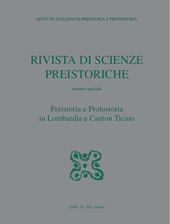La struttura cronologica dell'età del Bronzo in Italia settentrionale
P. 413-422
The Bronze Age is a period of European Protohistory that lasted over a millennium. In Italy it is subdivided into Early, Middle, Recent and Final. In northern Italy the further chronological articulation is based on the settlements stratigraphy and to a lesser extent on the closed finds of burial contexts. Fundamental points of reference are to the north of Po River the Lavagnone (Desenzano del Garda-Lonato, Brescia) and Fiavè in the Giudicarie valleys (Trento), to the south the terramara of Montale (Modena). The different chronological phases identified in these sites can be correlated with each other on the basis of some common pottery types. To translate relative chronology into absolute chronology, the tools that can be used are dendrochronology and the method of cross dating.
The relative chronology of northern Alpine area and central Europe can be correlated with that of northern Italy especially in some phases such as EBA II and MBA II B. By integrating the dendrochronological dating of Switzerland and southern Germany with the Italian ones from Lavagnone, Lucone, La Quercia di Lazise (Verona) and Viverone (Biella) it is possible to have a detailed picture of the absolute chronology of each archaeological phase. However, some problems still remain open, such as the precise chronological limits between EBA II and MBA I. [Publisher's text]
Fait partie de
Rivista di scienze preistoriche : LXXII, supplemento, 2022-
Articles du même numéro (disponibles individuellement)
-
Informations
Code DOI : 10.32097/1184
ISSN: 2282-457X


